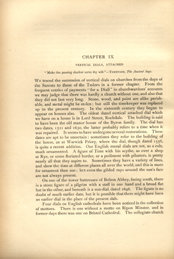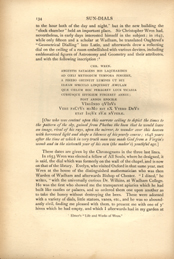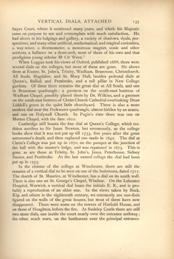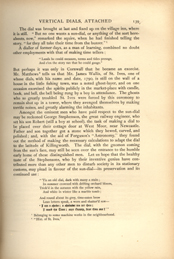CHAPTER IX
VERTICAL DIALS, ATTACHED
"Make the passing shadow serve thy will" — Tennyson, The Ancient Sage.
WE traced the succession of vertical dials on churches from the days of the Saxons to those of the Tudors in a former chapter. From the frequent entries of payments "for a Diall" in churchwardens' accounts we may judge that there was hardly a church without one, and also that they did not last very long. Stone, wood, and paint are alike perishable, and metal might be stolen; but still the timekeeper was replaced up to the present century. In the sixteenth century they began to appear on houses also. The oldest dated vertical attached dial which we have on a house is in Lord Street, Rochdale. The building is said to have been the old manor house of the Byron family. The dial has two dates, 1521 and 1630, the latter probably refers to a time when it was repaired. It seems to have undergone several restorations. These dates are apt to be uncertain ; sometimes they refer to the building of the house, as at Warwick Priory, where the dial, though dated 1556, is quite a recent addition. Our English mural dials are not, as a rule, much ornamented. A figure of Time with his scythe, as over a shop at Rye, or some floriated border, or a pediment with pilasters, is pretty nearly all that they aspire to. Sometimes they have a variety of lines, and show the time at different places all over the world, and this is more for ornament than use; but even the gilded rays around the sun's face are not always present.
On one of the tower buttresses of Bolton Abbey, facing south, there is a stone figure of a pilgrim with a staff in one hand and a broad flat hat in the other, and beneath it a sun-dial, dated 1646. The figure is no doubt of much earlier date, but it is possible that there might have been an earlier dial in the place of the present slab.
Four dials on English cathedrals have been noticed in the collection of mottoes. There is one without a motto on Ripon Minster, and in former days there was one on Bristol Cathedral. The collegiate church
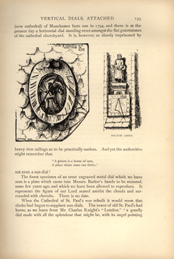
[Full Image]
Over ye Doorway of a boot-shop at RYE.
BOLTON ABBEY.
(now cathedral) of Manchester bore one in 1794, and there is at the present day a horizontal dial standing erect amongst the flat gravestones of the cathedral churchyard. It is, however, so closely imprisoned by heavy iron railings as to be practically useless. And yet the authorities might remember that
"A prison is a house of care,
A place where none can thrive,"
not even a sun-dial!
The finest specimen of an erect engraved metal dial which we have seen is a plate which came into Messrs. Barker's hands to be restored, some few years ago, and which we have been allowed to reproduce. It represents the figure of our Lord seated amidst the clouds and surrounded with cherubs. There is no date.
When the Cathedral of St. Paul's was rebuilt it would seem that clocks had begun to supplant sun-dials. The tower of old St. Paul's had borne, as we learn from Mr. Charles Knight's "London," "a goodly dial made with all the splendour that might be, with its angel pointing
to the hour both of the day and night," but in the new building the
"clock chamber" held an important place. Sir Christopher Wren had,
nevertheless, in early days interested himself in the subject; in 1647,
while only fifteen and a scholar at Wadham, he translated Oughtred's
"Geometrical Dialling" into Latin, and afterwards drew a reflecting
dial on the ceiling of a room embellished with various devices, including
emblematical figures of Astronomy and Geometry and their attributes,
with the following inscription: 1
| CHR. WREN. |
| ANGUSTIS SATAGENS HIS LAQUEARIBUS |
| AD CŒLI METHODUM TEMPORA PINGERE, |
| A PHŒBO OBTINUIT LUMINIS UT SUI |
| IDÆAM SPECULO LINQUERET ÆMULAM |
| QUÆ CŒLUM HOC PERAGRET LUCE VICARIA |
| CURSUSQUE EFFIGIEM FINGERET ANNUI; |
| POST ANNOS EPOCHÆ |
| VIRGINEO QVIBVS |
| VERE FACTVS HOMO EST EX VTERO DEVS |
| ETAT ISQVE SVÆ NVPERÆ. |
[One who was content upon this narrow ceiling to depict the times to the pattern of the sky, gained from Phœbus the boon that he would leave an image, rival of his rays, upon the mirror, to wander over this heaven with borrowed light and shape a likeness of his yearly course; 1648 years after the time at which in very truth man was made God from a Virgin's womb and in the sixteenth year of his own (the maker's) youthful age.]
These dates are given by the Chronograms in the three last lines.
In 1653 Wren was elected a fellow of All Souls, where he designed, it is said, the dial which was formerly on the wall of the chapel, and is now on that of the library. Evelyn, who visited Oxford in that same year, met Wren at the house of the distinguished mathematician who was then Warden of Wadham and afterwards Bishop of Chester. "I dined," he writes, "with the universally curious Dr. Wilkins, at Wadham College. He was the first who showed me the transparent apiaries which he had built like castles or palaces, and so ordered them one upon another as to take the honey without destroying the bees. These were adorned with a variety of dials, little statues, vanes, etc., and he was so aboundantly civil, finding me pleased with them, to present me with one of ye hives which he had empty and which I afterwards had in my garden at
1 Elmer's "Life and Works of Wren."
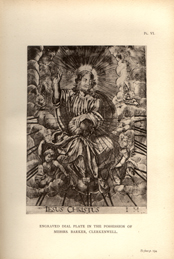
[Full Image]
IESUS CHRISTUS IH
ENGRAVED DIAL PLATE IN THE POSSESSION OF MESSRS. BARKER, CLERKENWELL.
To face page 134.
Sayes Court, where it continued many years, and which his Majestie came on purpose to see and contemplate with much satisfaction. He had above in his lodgings and gallery, a variety of shadows, dyals, perspectives, and many other artificial, mathematical, and magical curiosities, a way-wiser, a thermometer, a monstrous magnet, conic and other sections, a ballance on a demi-arch, most of them of his own and that prodigious young scholar Mr Chr Wren."
When Loggan took his views of Oxford, published 1688, there were several dials on the colleges, but most of these are gone. He shows them at Exeter, St. John's, Trinity, Wadham, Brasenose, Christchurch, All Souls, Magdalen, and St. Mary Hall, besides pedestal dials at Queen's, Balliol, and Pembroke, and a tall pillar in New College gardens. Of these there remains the great dial at All Souls, and one in Brasenose quadrangle; a gnomon on the south-east buttress of Wadham Chapel, possibly placed there by Dr. Wilkins, and a gnomon on the south-east buttress of Christ Church Cathedral overlooking Dean Liddell's grave in the quiet little churchyard. There is also a more modern dial near the Peckwater quadrangle, almost hidden by an acacia, and one on Holywell Church. In Pugin's time there was one on Merton Chapel, with the date 1622.
Cambridge still boasts the fine dial at Queen's College, which tradition ascribes to Sir Isaac Newton, but erroneously, as the college books show that it was not put up till 1733, five years after the great astronomer's death, and then replaced one made in 1642. The dial at Christ's College was put up in 1670, on the parapet at the junction of the hall with the master's lodge, and was repainted in 1673. This is gone, as are those at Trinity, St. John's, Jesus, Peterhouse, Sidney Sussex, and Pembroke. At the last named college the dial had been put up in 1553.
In the cloister of the college at Winchester, there are still the remains of a vertical dial to be seen on one of the buttresses, dated 1712. The church of St. Maurice, at Winchester, has a dial on its south wall. There is also one on St. George's Chapel, Windsor. On the Leicester Hospital, Warwick, a vertical dial bears the initials E. R., and is probably a reproduction of an older one. In the views taken by Buck, Kip, and others in the eighteenth century, we constantly see sun-dials figured on walls of the great houses, but most of them have now disappeared. There were some on the towers of Hatfield House, and on those of Houghton, before the fire. At Sudeley Castle there are still two stone dials, one inside the court nearly over the entrance archway; the other, much worn, on the battlement over the principal entrance.
Charlecote also has its dial on the south wing, and there is one on the Old Bar at Southampton. On the beautiful ruins of Wingfield Manor House, in Derbyshire, the gnomons of two vertical dials can still be seen. The dials were made about 1678 by Immanuel Halton, astronomer and mathematician, who then lived in the Manor House, which his family had bought after the Civil Wars, and which he partly repaired. It had stood two sieges and was left in a ruinous condition. One of the dials is over the bay window of the banquetting hall, the other over a window near the state rooms, once occupied by Mary, Queen of Scots.
Though the dial at Queen's College was not designed by Sir Isaac Newton, he left tokens of his boyish handiwork as a dialler. One he painted on a ceiling in his grandmother's house at Market Overton. It was no doubt like Wren's, a reflective, or as it was then called, a "spot dial," where a speck of light was cast upon the hour lines on the ceiling from a piece of looking-glass which was fixed horizontally in a south window, and reflected the rays of the sun. The house in which Mrs. Ayscough lived was pulled down some years ago, but the piece of plaster with the dial face upon it has been preserved, and is kept in the house built upon the old site.
Sir Isaac Newton also carved both the dials on the south end of the Manor House at Woolsthorpe, in the parish of Colsterworth, Lincolnshire, where he was born. They are figured in a view of the house given in Sir David Brewster's "Life of Newton," and are semicircular, and divided into twelve hour spaces. Under one of the dials Newton carved his name, and this dial stone was taken out of the wall in 1844, and presented to the Museum of the Royal Society, where it is carefully preserved. In 1876-77 the manorial aisle to the chancel of Colsterworth Church was rebuilt; it is called the Newton Chapel, because Sir Isaac's ancestors were buried in it, and Sir William Erle offered to present a copy of the dial in the Royal Society's Museum to Colsterworth Church. The Rev. John Mirehouse, vicar of the parish, at first accepted this offer, but afterwards thought he would make a search at Woolsthorpe Manor and see if the second dial which Newton was known to have carved could be found. His effort was rewarded with success. The old stone was found in its original position on the south wall, covered up by a small coal house, and the relic was given by the owner of Woolsthorpe to the church. The disc is 11 inches wide at the top, and nearly 6 inches deep; it has been enclosed in a frame of alabaster and placed on the north wall of the Newton Chapel, with the following inscription:
"Newton: aged 9 years, cut with his penknife this dial: The stone
was given by C. Turner, Esq., and placed here at the cost of the Rt. Hon: Sir William Erle, a collateral descendant of Newton, 1877."
On the church of Seaton Ross, a little village in the East Riding of Yorkshire, there is a plain south dial, made by William Watson, a farmer, who died in 1857 and lies buried in the churchyard. On his gravestone are the lines:
"At this church I so often with pleasure did call,
That I made a sun-dial upon the church wall."
Mr. Watson made several other dials in the neighborhood, and printed a little book of directions for their construction. The house where he lived is still called Dial House, and had four dials on the wall, now quite gone to decay. His successors did not value them. "Them fond things," as they were disrespectfully called by one of the younger generation; "If I were thou, Father, I'd have them figures away if I scratted them off wi' my nails." The father only laughed, and observed that "the lad mun' ha' a deal o' time to waaste;" and the dials were left to perish in their own way.
A younger neighbour of William Watson's, John Smith of Beilby, who also distinguished himself as a dialler, is mentioned in the collection of mottoes. He was a remarkable man in his way. From his boyhood he took great interest in astronomy, meteorology, dialling, and mechanics, and spent much of his spare time in a carpenter's shop, where he made a pedometer for his father's waggon. The ability came from his mother's side of the house, and she encouraged these pursuits, but John had to encounter a good deal of opposition from his father, who complained that the lad was always "agate o' them gimcracks." He left signs of his handiwork behind him at Beilby, and after living for several years as a farmer in the East and North Ridings, removed to South Stockton, where he devoted himself to astronomical pursuits, including the construction of sun-dials, and the publication of a meteorological almanack. Smith was a Wesleyan local preacher, and his active life was once graphically described by one of his neighbors at Spaldington, when asked to subscribe towards a testimonial which was to take the form of an easy chair, "Pooh pooh! Smith is a man that nivver sits. Pray what use will an easy hame chair be tiv him? He's working hard all t' day lang i' t' farm, and up star-gazing at neets, and out preaching o' Sundays. Ah weant be a farthing towards nae sic thing as that, that ah wean't, sea ah'l say it at yance."
John Smith lived to the age of eighty-eight, and died at South Stockton in 1895.
The race of country diallers is happily not yet extinct. Mr. Joseph Angus, a foreman quarryman, has made several dials, horizontal and vertical, for his cottage and garden at Crawleyside, co. Durham. The late Mr. Serjeantson, of Camphill, Yorkshire, who put up two or three dials on his farms, had them made by two intelligent village masons, according to the directions given in the "Encyclopædia Britannica," and they were set up with the help of a candle, a piece of string, and the north star. Mr. Serjeantson, who died a few years ago at the age of eighty-nine, used to relate how, in his earlier days, he had painted a signboard representing the Queen and Prince Albert on horseback, for the village inn at Kirkby Malham, near his own property. He wished to put a sun-dial above it, and accordingly wrote to a well-known dialler in the neighbourhood. Time went on, a general election was pending, and late one evening the dialler was driven up to Mr. Serjeantson's door by a neighbour, who had fetched him out of a public-house, and urged the squire to keep him, or he would vote wrong. When politics had been discussed the squire began to speak about the dial, and supposed nothing could be done about it that night as it was so late. "Naw," said the old man looking up at the stars, "it'll do varra weel, it's a gran' neet." "But you want the sun, don't you?" "Nay, nay, t' sun's nought to do wi't. I wants nought but a tall cannel and a bit o' band." With these materials the party proceeded to the village and the position of the dial was fixed. But the order was so long in being executed, that after waiting some months the squire wrote to remonstrate, and received in return the following curious letter;
"Carlton, July, 1843.
"DEAR SIR,
"Ever since I have imbrased every applicable opportunity possible for a complition, and yet after all defeated! if I could possess you (but I have treated you so) we will let alone fixing a time, the model will take two or three days yet to finish it, you need not be afraid of any preposterous executions (because it might fright Her Majesties Horses as her Royal Highness and her consort Prince will ride over every day)1 though I could like somewhat handsome with regard to its perspicuous situation, and a little towards a melioration of my conduct towards you.
"I have for the present resolved it the most extant job I have on hand, if I am well shall not delay another hour till it is finished, but every process requires its own time, say two days to finish the Model, one day in casting, when I take it to Keighley (on my way to Wilsden to see my sister whom I've anxiously expected), then its to paint and Gild, but I must be over at Kirby in the meantime but cannot with any propriety fix a day yet,
"Dear Sir,
"Your humble Servant,
"WM. CRYER."
1 Alluding to the signboard.
The dial was brought at last and fixed up on the village inn, where it is still. "But no one wants a sun-dial, or anything of the sort hereabouts, now," remarked the squire, when he had finished telling the story, "for they all take their time from the buzzer." 1
A dialler of former days, as a man of learning, combined no doubt other employments with that of making time tellers:
"Lands he could measure, terms and tides presage,
And e'en the story ran that he could gauge."
But perhaps it was only in Cornwall that he became an exorcist. Mr. Matthews 2 tells us that Mr. James Wallis, of St. Ives, one of whose dials, with his name and date, 1790, is still on the wall of a house in the little fishing town, was a noted ghost-layer, and on one occasion exorcised the spirits publicly in the market-place with candle, book, and bell, the bell being rung by a boy in attendance. The ghosts who so greatly troubled St. Ives were forced by this ceremony to remain shut up in a tower, where they avenged themselves by making terrific noises, and greatly alarming the inhabitants.
Amongst the eminent man who have paid respect to the sun-dial may be reckoned George Stephenson, the great railway engineer, who set his son Robert (still a boy at school), the task of making a dial to be placed over their cottage door at West Moor, near Newcastle. Father and son together got a stone which they hewed, carved, and polished; and, with the aid of Ferguson's "Astronomy," they found out the method of making the necessary calculations to adapt the dial to the latitude of Killingworth. The dial, with the gnomon coming from the sun's face, may still be seen over the entrance to the humble early home of these distinguished men. Let us hope that the healthy taste of the Stephensons, who by their inventive genius have contributed more than any other men to disturb society in its stationary customs, may plead in favour of the sun-dial — its preservation and its continued use;
"'Tis an old dial, dark with many a stain;
In summer crowned with drifting orchard bloom,
Trick'd in the autumn with the yellow rain,
And white in winter like a marble tomb;
And round about its grey, time-eaten brow
Lean letters speak, a worn and shatter'd row —
' I am a shade: a shadowe too are thou:
I mark the Time: saye Gossip, dost thou soe?'"
1 Belonging to some machine works in the neighborhood.
2 "Hist. of St. Ives."
